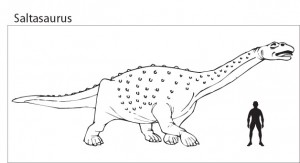Baby Sauropod Trackways Reported from South Korea
The National Heritage Centre under the National Research Institute of Cultural Heritage of the South Korean Government announced this week that more evidence of the country’s dinosaur past had been discovered. South Korea is fast building a reputation for exceptional Mesozoic body and trace fossils, a number of important finds have already been studied but this new discovery may shed light on the ontogeny of dinosaurs (the development of individuals – how dinosaurs grew).
A number of discoveries have been made in South Korea recently, to read more trace fossils found in this country: Two-toed footprints found in Korea, evidence of Dromaeosaurs.
Dinosaur Trackways
A series of fossilised trackways have been found in Euiseong County, North Gyeongsang Province in the south-east of the country. These well preserved trace fossils seem to show the footprints of two small sauropod dinosaurs, possibly juveniles. The fossils have been dated to the Cretaceous, around 110 million years ago (Albian faunal stage).
In total, 61 sauropod footprints have been found, stretching across 4.25 metres, making this the longest fossil trackway of baby dinosaurs found to date. The footprints were made as these small dinosaurs, wandered across muddy land, the area is criss-crossed with other trackways made by dinosaurs, some of which can be seen in the diagram.
The direction of travel is difficult to make out in the picture, although the sauropod trackway on the left, indicates that this animal was travelling from the top of the picture to the bottom, the other trackway is too unclear in this picture to make out the direction of travel. The lack of any object such as ruler or pencil to provide scale, makes it difficult to interpret the evidence. It is almost impossible to relate any trace fossils such as footprints to a particular genus, although the imprints are typical of titanosaurids (a branch of the sauropod family that was relatively common in the Southern Hemisphere during the Cretaceous).
It is not known what sort of titanosaur made these trackways, or indeed if it was a titanosaur, as the morphology of the animal may change as they grow bigger. titanosaurs were long-necked, heavy set, herbivorous dinosaurs. A typical titanosaur was Saltasaurus (a genus of titanosaur known from South America).
Saltasaurus – a Typical Titanosaur
Picture credit: Everything Dinosaur
To view a range of long-necked dinosaur models: Dinosaur and Prehistoric Animal Models.
Little is known about the ontogeny of dinosaurs, how animals such as titanosaurs could hatch from an egg no bigger than a football and grow into huge beasts over 20 metres long and weighing tens of tonnes. Certainly, the titanosaurs represent some of the largest land animals ever to have lived and giants like Paralititan (Egypt), Argentinosaurus and Antarctosaurus (South America) could perhaps exceed 30 metres in length and weigh upwards of 100 tonnes.
Interpreting these fossil trackways are complicated due to the lack of other fossil evidence related to baby dinosaurs. Adult titanosaur footprints are easily distinguished from other sauropod footprints such as diplodocids and brachiosaurids by their relatively wider gait, but very little is known about how dinosaurs grew and matured. Perhaps, if these tracks were made at the same time, this might indicate that juveniles stayed together in a creche for protection, although any such deductions are highly speculative given the evidence from the fossil record discovered to date.
The Government of South Korea has applied to UNESCO for part of the country’s coastline where Cretaceous sediments are exposed to be given World Heritage status. This would give this area the same preservation status as other natural wonders such as the Great Barrier Reef off Australia.
To read more: Korea makes bid for World Heritage status for Cretaceous coastline.







Leave A Comment